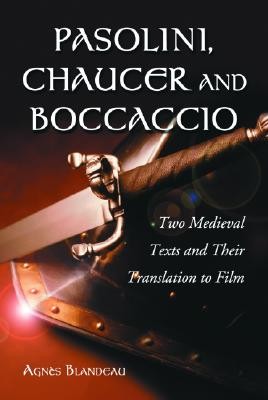
- We will send in 10–14 business days.
- Author: Agnès Blandeau
- Publisher: McFarland & Company
- ISBN-10: 0786422475
- ISBN-13: 9780786422470
- Format: 15.3 x 22.9 x 1.4 cm, softcover
- Language: English
- SAVE -10% with code: EXTRA
Reviews
Description
Pier Pasolini's trilogy of life is a series of film adaptations of major texts of the past: The Decameron, The Canterbury Tales, and One Thousand and One Nights. The movies demonstrate a film author's acute aesthetic sensibility through a highly original cinematic rendering of the sources. The first two films, closely examined in this book, offer a personal, purposefully stylized vision of the Middle Ages, as though Pasolini were dreaming Boccaccio's and Chaucer's texts through the filter of his heretic consciousness. The unusual poetic visualization of the source works, which could be described as irreverent cinematic homage, has the potential to renew the traditional reading of such literature. This book shows how cinema becomes an alternative form of storytelling. It first studies the two films in detail, putting them in perspective within the trilogy. Next it interprets them, recounting misinterpretations and expounding upon Pasolini's ideological perception, and defends the oft-criticized adaptations. Finally, it discusses how the films represent innovation over strict adaptation. Appendices offer charts with information on the narrative structures of the films and the correspondences between them.
EXTRA 10 % discount with code: EXTRA
The promotion ends in 18d.17:52:20
The discount code is valid when purchasing from 10 €. Discounts do not stack.
- Author: Agnès Blandeau
- Publisher: McFarland & Company
- ISBN-10: 0786422475
- ISBN-13: 9780786422470
- Format: 15.3 x 22.9 x 1.4 cm, softcover
- Language: English English
Pier Pasolini's trilogy of life is a series of film adaptations of major texts of the past: The Decameron, The Canterbury Tales, and One Thousand and One Nights. The movies demonstrate a film author's acute aesthetic sensibility through a highly original cinematic rendering of the sources. The first two films, closely examined in this book, offer a personal, purposefully stylized vision of the Middle Ages, as though Pasolini were dreaming Boccaccio's and Chaucer's texts through the filter of his heretic consciousness. The unusual poetic visualization of the source works, which could be described as irreverent cinematic homage, has the potential to renew the traditional reading of such literature. This book shows how cinema becomes an alternative form of storytelling. It first studies the two films in detail, putting them in perspective within the trilogy. Next it interprets them, recounting misinterpretations and expounding upon Pasolini's ideological perception, and defends the oft-criticized adaptations. Finally, it discusses how the films represent innovation over strict adaptation. Appendices offer charts with information on the narrative structures of the films and the correspondences between them.


Reviews